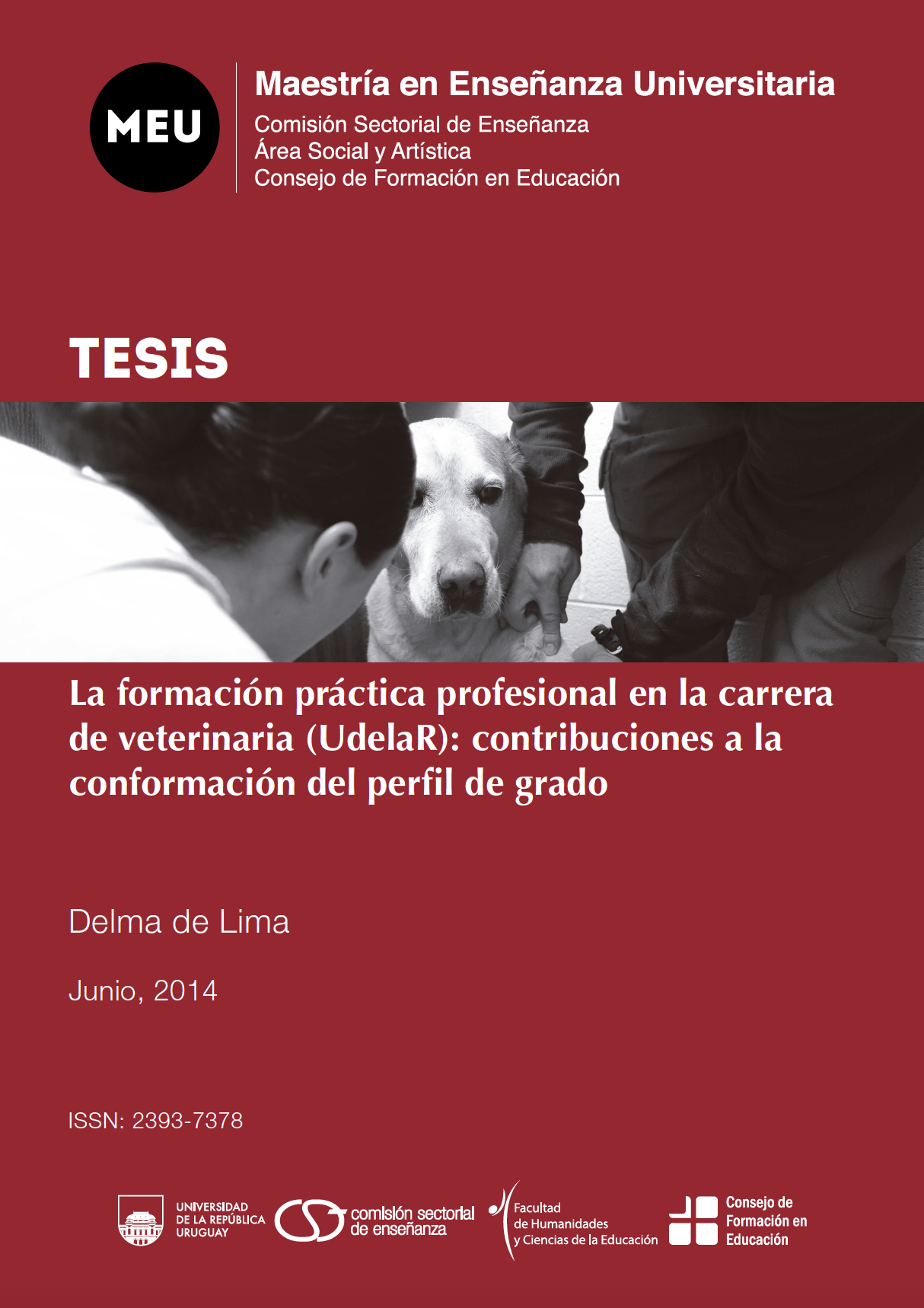Resumen
La finalidad de esta investigación fue ampliar el conocimiento sobre la problemática del último año de la carrera de Veterinaria, donde transcurre el aprendizaje de las prácticas profesionales, procurando profundizar desde el punto de vista didáctico en los tipos de formación desarrollados, en su vinculación con las diversas formas del ejercicio profesional y los perfiles profesionales promovidos a nivel regional. Tradicionalmente, en las carreras de corte científico-técnico, en los primeros tramos se proporcionan los fundamentos científicos del campo profesional, en tanto que las competencias profesionales básicas se adquieren en tramos avanzados, fundamentalmente mediante prácticas. Los practicantados se conciben como experiencias de aprendizaje situadas en contextos reales, que contribuyen a la capacitación profesional y a la formación social y emocional del estudiante, aportando significativamente a la conformación de la identidad profesional. Se analizaron comparativamente los proyectos de formación que brindan las tres orientaciones de la carrera de Veterinaria (Plan 1998) y su interrelación con las prácticas profesionales actuales, abordando tres ejes de análisis a nivel del currículo prescripto: a) el perfil y los objetivos de formación, b) la selección y la organización de los contenidos, c) las orientaciones pedagógicas para la enseñanza. Se aplicó una estrategia de investigación cualitativa, en la modalidad estudio de caso, desde una perspectiva interpretativa. Se realizó una consulta sistemática de los documentos curriculares e institucionales disponibles y se relevó la visión de diversos actores institucionales a través de entrevistas semi-estructuradas. Se destacan como principales conclusiones las siguientes. 1) Las competencias que se espera que el estudiante logre en el último tramo de la carrera, en su mayoría, se ajustan a los estándares de desempeño del Veterinario acordadas por el sistema ARCUSUR de acreditación regional de carreras y en los foros académico-profesionales. 2) La formación práctica profesional en la carrera de Veterinaria, por diversas razones, contribuye al perfil de egreso generalista en un grado limitado, de modo que los graduados deben transitar por otra Orientación, proseguir estudios de postítulo y/o adquirir nuevas competencias mediante la formación experiencial. 3) En la diversidad estructural, organizativa y conceptual que se expresa en los practicantados, independientemente de las limitantes identificadas, se reconocen innovaciones relevantes que encierran un alto potencial de transformación de los métodos tradicionales de enseñanza hacia formas de aprendizaje más activas y participativas, que se articulan con la asistencia en salud, la extensión y la investigación a través de la realización de tesis de grado. Estos elementos deberían ser considerados a la hora de proponer alternativas de formación en y para la práctica profesional en el proceso de reforma curricular.
Palabras claves
Prácticas, Perfil profesional, Enseñanza veterinaria
Abstract
The purpose of this research was to expand knowledge on the issue of final year veterinary career where learning takes professional practices, seeking further from the pedagogical point of view on the types of training developed in their relationship with the various forms of professional practice and professional profiles promoted regionally. Traditionally, in the careers of scientific-technical cut in the first sections are provided the scientific basis of the professional field, while the basic skills acquired in advanced stages, primarily through practice. The practicantados are conceived as situated learning experiences in real contexts that contribute to the professional development and training of student social and emotional development, contributing significantly to the formation of professional identity. Were analyzed comparatively training projects that provide the three orientations of Veterinary career (1998 Plan) and its interface with current professional practices, addressing three areas of analysis prescribed curriculum level: a) the profile and training objectives, b) the selection and organization of content, c) educational guidelines for teaching. We applied a qualitative research strategy, the case study method, from an interpretative perspective. We conducted a systematic inquiry and institutional curriculum documents available and collected the vision of various institutional actors through semi-structured interviews. Analyzing syllabuses and interviews, we conclude that according to the selected orientation, students acquire skills because they propose different learning experiences dissimilar. Although not all transit evaluate positively their guidance and practicantado, respondents have gained employment in line with their expectations. The teachers expressed varying degrees of satisfaction with the institutional framework, the curricular and academic outcomes, depending on the orientation in which they work. In its most traditional forms of teaching applied and report having difficulty providing equivalent internship opportunities to all students, because of the lack of resources and numerosity. Professionals expressed the link between changes implemented curriculum and professional profile, coinciding with the decisive role is allocated to this factor in curriculum theory.
The application of this methodology to the analysis of other career levels can contribute
significantly to the curriculum reform process.
It highlights the Following main conclusions. 1) The skills students are expected to achieve in
the last stretch of the career, mostly conform to performance standards by the Veterinary
ARCUSUR Agreed regional system of Accreditation of courses and the academic and
professional forums. 2) The practical training in the professional career of Veterinary
Medicine, for various reasons, contributes to the generalist egress profile to a limited extent,
so that graduates must pass through another orientation, pursue postgraduate studies and /
or acquiring new skills through experiential training. 3) in structural, organizational and
conceptual diversity embodied in practicantados regardless of the identified constraints, is
that relevant innovations hold great potential to transform traditional methods of teaching into
a more active and participatory learning are recognized, that articulate with health care,
outreach and research through conducting thesis. These elements should be considered
when proposing alternatives for training and practice in the process of the curriculum reform.
Keywords
Practice, Professional profile, Veterinary education
Director(es) de tesis
- Mag. Mercedes Collazo
Tribunal
- Elisa Lucarelli
- Perla Cabrera
- Mercedes Collazo
Fecha de Aprobación
10/06/2014
Dictamen
Aprobado con mención



